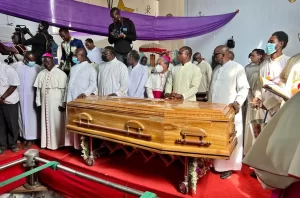The Emeritus Bishop of Konongo-Mampong Diocese, the Most Rev. Joseph Osei-Bonsu, has explained into details why a Bishop is buried in his Cathedral and not at the Priests’ Cemetery.
His explanation was in response to a question by Mrs. Roberta Addae on the Bishop Emeritus’ Whatsapp page.
The question was “My Lord, I would like to know why Bishops and Archbishops are buried in the Cathedral and not at the Priests’ cemeteries.”
Below is the answer by Bishop Joseph Osei-Bonsu:
Canon 1242 encourages the burial of bishops in their cathedral: “Unless another provision has been made by the bishop himself, diocesan bishops are to be buried in their own cathedral church”. This norm reflects the Church’s desire to honour the bishop’s service and maintain a tangible connection between the bishop and the diocese he served. It is clear from this Canon that it is the custom in the Church that bishops are buried in their cathedral churches.
However, there are exceptions. Some bishops may choose to be buried in a different location, such as a monastery or a family plot, due to personal or historical reasons. However, the question that may be asked is: was it always the case that, generally speaking, bishops were buried in their cathedrals when they died?
In the early Church, bishops, as a general rule, would have been buried in church cemeteries – where they existed – or on the church premises. They would not have been buried in their cathedrals. However, the practice of burying bishops in their cathedrals is something that arose when Christians started suffering persecution, especially martyrdom, in the practice of their faith. We should note that the first churches erected after the early Christian house churches were built near or directly over the graves of martyrs. It was the practice for Christians to build altars and, later, cathedrals and basilicas, over the tombs of the saints, especially martyrs. Christians celebrated the Eucharist on the very tombs of the martyred dead, partly in the belief that those dead heroes were “friends of God” who would help to carry forward their prayers in heaven.

Over the years, there was a close relationship between the remains of martyrs and other saints with the physical cathedral structure. The Eucharist was thus usually celebrated at the gravesites of the martyrs, which gave rise to the tradition of placing relics of the saints in or near the altar. The tradition of burying bishops in their cathedrals began with martyred bishops being buried in their cathedrals in the fourth century, and this practice was gradually extended to all diocesan bishops, whether they were martyrs or not.
During the Middle Ages, it became a common practice for bishops to be buried in the cathedral, often in a prominent location such as the nave or the choir.
The practice of burying bishops in cathedrals is a longstanding tradition in the Catholic Church and reflects the bishop’s spiritual leadership and his deep connection to the local Church that he served. Here are the key reasons why bishops are traditionally buried in their cathedrals.

Theological Reasons
Three theological reasons have been adduced for the burial of bishops in the cathedral. The first is that the bishop is the shepherd of the flock. He is considered the spiritual shepherd of the local Church, and being buried in the cathedral symbolizes his ongoing presence and care for his flock even in death. The second reason is based on the belief in the doctrine of the Communion of Saints. The burial of the bishop in the cathedral reflects the Catholic belief in the Communion of Saints, which emphasizes the spiritual bond between the living and the dead. The Communion of Saints binds the faithful on earth (Church Militant), souls in purification (Church Suffering), and saints in heaven (Church Triumphant) into a single body under Christ’s headship. The cathedral (from the Latin cathedra, meaning “chair”) is the principal church of a diocese, where the bishop’s cathedra (“chair”) is located. It symbolizes the bishop’s authority and his role as the chief shepherd of the local Church.
Burying the bishop in the cathedral underscores his lifelong service to the diocese and his spiritual fatherhood over the faithful. The third reason has to do with the fact that the bishop’s burial in the cathedral is a powerful reminder of the Paschal Mystery – the death and resurrection of Christ. Just as Christ conquered death, the bishop’s tomb in the cathedral points to the hope of eternal life. It also reflects the bishop’s role as a steward of the mysteries of God (1 Corinthians 4:1), entrusted with the care of the Church and the salvation of souls.

Symbolic Reasons
Two symbolic reasons have been adduced in support of the idea of the bishop being buried in his cathedral. The first has to do with his connection to the local church. Burial in the cathedral serves as a visible reminder of the bishop’s connection to the local Church and his role in its history and development. The second reason has to do with the cathedral as a symbol of unity. The cathedral, often considered the mother church of the diocese, represents the spiritual home of the diocese, and the burial of bishops within its walls symbolizes the unity of the local Church under their leadership.
Connection to the Eucharist
The cathedral is the primary place where the Eucharist is celebrated in the diocese. Burying the bishop near the altar or at any place in the cathedral emphasizes his role as a minister of the sacraments, particularly the Eucharist, which is the source and summit of the Christian life.
Veneration and Pilgrimage
Bishops, especially those who lived holy lives or were martyred, were often venerated by the faithful. Their tombs in the cathedral became places of prayer and pilgrimage, where the faithful could seek their intercession. This tradition continues today, as the tombs of bishops serve as a reminder of their spiritual legacy and a focal point for devotion.
Conclusion
Burying bishops in cathedrals is a profound tradition that honours their spiritual leadership and connects them to the local Church they served. It is a testament to the bishop’s role as a shepherd, teacher, and father to the faithful, and it serves as a lasting reminder of the Church’s hope in the resurrection and eternal life.
For further explanations or enquiries, you may contact the author, Most Rev. Joseph Osei-Bonsu, Emeritus Bishop of Konongo-Mampong, on this number: 0244488904, or on WhatsApp (with the same number).



